
Naval Air Station Jacksonville is a large naval air station located approximately eight miles (13 km) south of the central business district of Jacksonville, Florida, United States.

USS Sicard (DD-346/DM-21/AG-100) was a Clemson-class destroyer in the United States Navy following World War I. She was named for Montgomery Sicard.

Naval Station Norfolk Chambers Field (IATA: NGU, ICAO: KNGU, FAA LID: NGU),or LP-1/Chambers Field, is commonly known simply as, Chambers Field, and is named after Captain Washington Irving Chambers. It is a military airport in Norfolk, Virginia that is a part of Naval Station Norfolk. It supports naval air forces in the United States Fleet Forces Command, those operating in the Atlantic Ocean, Mediterranean Sea, and Indian Ocean. It's important to note that, "Chambers Field" only refers to the geographical area of the airport runway, taxiways, two heliports and six helipads.

USS Foss (DE-59) was a Buckley-class destroyer escort of the United States Navy, in service from 1943 to 1957. She was sunk as a target in September 1966.
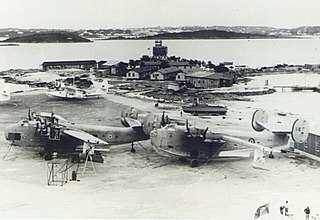
The Royal Air Force (RAF) operated from two locations in the Imperial fortress colony of Bermuda during the Second World War. Bermuda's location had made it an important naval station since US independence, and, with the advent of the aeroplane, had made it as important to trans-Atlantic aviation in the decades before the Jet Age. The limited, hilly land mass had prevented the construction of an airfield, but, with most large airliners in the 1930s being flying boats, this was not initially a limitation.

Naval Air Station Cecil Field or NAS Cecil Field was a United States Navy air base, located in Duval County, Florida. Prior to October 1999, NAS Cecil Field was the largest military base in terms of acreage in the Jacksonville, Florida area.
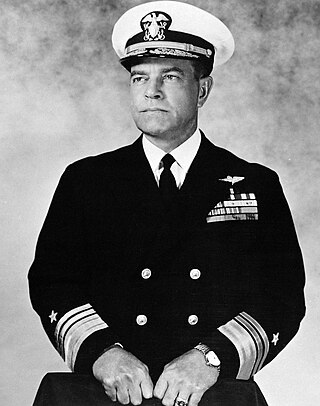
Patrick Nieson Lynch Bellinger CBE was a highly decorated officer in the United States Navy with the rank of Vice Admiral. A Naval aviator and a naval aviation pioneer, he participated in the Trans-Atlantic flight from Newfoundland to Azores in May 1919 and was decorated with Navy Cross, the United States military's second-highest decoration awarded for valor.
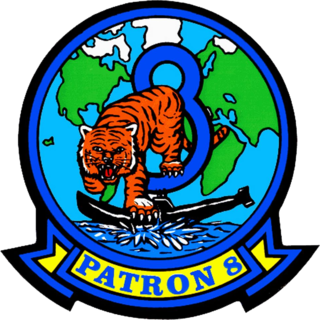
Patrol Squadron Eight (VP-8) is a U.S. Navy land-based patrol squadron stationed at Naval Air Station Jacksonville, Florida (USA). VP-8 is tasked to undertake maritime patrol, anti-submarine warfare (ASW), and intelligence, surveillance and reconnaissance (ISR) missions. The Squadron is equipped with the Boeing P-8A Poseidon.
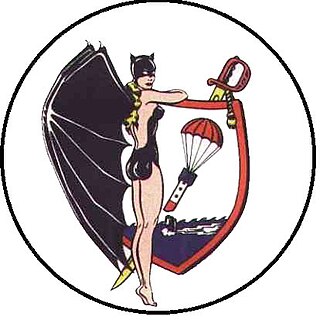
Patrol Squadron 24 (VP-24) was a Patrol Squadron of the U.S. Navy. The squadron was established as Bombing Squadron One Hundred Four (VB-104) on 10 April 1943, redesignated as Patrol Bombing Squadron One Hundred Four (VPB-104) on 1 October 1944, redesignated as Patrol Squadron One Hundred Four (VP-104) on 15 May 1946, redesignated Heavy Patrol Squadron (Landplane) Four (VP-HL-4) on 15 November 1946, redesignated Patrol Squadron Twenty Four (VP-24) on 1 September 1948, the third squadron to be assigned the VP-24 designation, redesignated Attack Mining Squadron Thirteen (VA-HM-13) on 1 July 1956, redesignated Patrol Squadron Twenty Four (VP-24) on 1 July 1959 and disestablished 30 April 1995.
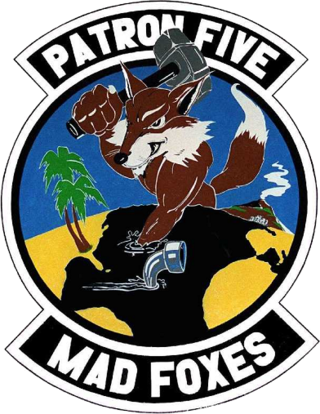
Patrol Squadron FIVE (VP-5) is a long-lived maritime patrol squadron of the United States Navy. It is the second squadron to bear the VP-5 designation. VP-5 is the second oldest patrol squadron, the fourth oldest in the United States Navy, and the 33rd oldest squadron in the United States military. As of 2019, VP-5 is still active and is based at Naval Air Station Jacksonville, Florida.

Patrol Squadron One (VP-1), established 15 February 1943, is an active aviation squadron of the United States Navy operating the Boeing P-8A Poseidon aircraft from its home port at Naval Air Station Whidbey Island, Washington, United States. The squadron is known by its nickname "Screaming Eagles", adopted in 1985 replacing its previous nickname, "Fleet's Finest". The squadron went by the call sign "BACKDOOR" during the 1960s and 1970s.

Charles Perry Mason was a highly decorated officer in the United States Navy with the rank of Vice admiral. An early naval aviator, he distinguished himself as Commanding officer of aircraft carrier USS Hornet (CV-8), which was sunk during the Battle of the Santa Cruz Islands in late October 1942. Mason was subsequently promoted to Rear admiral and served successively as Commander, Aircraft, Solomons and Chief of the Naval Air Intermediate Training Command at Naval Air Station Pensacola, Florida.

VPB-23 was a patrol bombing squadron of the U.S. Navy. The squadron was established as Patrol Squadron 10-S (VP-10S) on 1 July 1930, redesignated Patrol Squadron 10-F (VP-10F) on 17 July 1933, redesignated Patrol Squadron 10 (VP-10) on 1 October 1937, redesignated Patrol Squadron 25 (VP-25) on 1 July 1939, redesignated Patrol Squadron 23 (VP-23) on 1 August 1941, redesignated Patrol Bombing Squadron 23 (VPB-23) on 1 October 1944 and disestablished on 25 January 1946.
VPB-24 was a Patrol Bombing Squadron of the U.S. Navy. The squadron was established as Patrol Squadron 9-S (VP-9S) on 7 January 1930, redesignated Patrol Squadron 9-B (VP-9B) on 1 October 1930, redesignated Patrol Squadron 9-F (VP-9F) on 26 October 1931, redesignated Patrol Squadron 9 (VP-9) on 1 October 1937, redesignated Patrol Squadron 12 (VP-12) on 1 July 1939, redesignated Patrol Squadron 24 (VP-24) on 1 August 1941, redesignated Patrol Bombing Squadron 24 (VPB-24) on 1 October 1944 and disestablished on 20 June 1945.
VPB-29 was a Patrol Bombing Squadron of the U.S. Navy. The squadron was established as Pacific Air Detachment on 17 January 1923, redesignated Patrol Squadron 14 (VP-14) on 29 May 1924, redesignated Patrol Squadron 1-Naval District 14 (VP-1D14) on 21 September 1927, redesignated Patrol Squadron 1-B (VP-1B) on 1 July 1931, redesignated Patrol Squadron 1-F (VP-1F) on 15 April 1933, redesignated Patrol Squadron 1 (VP-1) on 1 October 1937, redesignated Patrol Squadron 21 (VP-21) on 1 July 1939, redesignated Patrol Squadron 1 (VP-1) on 30 July 1940, redesignated Patrol Squadron 101 (VP-101) on 3 December 1940, redesignated Patrol Bombing Squadron 29 (VPB-29) on 1 October 1944 and disestablished on 20 June 1945.

VP-33 was a Patrol Squadron of the U.S. Navy. The squadron was established as Patrol Squadron 12-F (VP-12F) on 1 November 1935, redesignated Patrol Squadron 12 (VP-12) on 1 October 1937, redesignated Patrol Squadron 51 (VP-51) on 1 July 1939, redesignated Patrol Squadron 71 (VP-71) on 1 July 1941, redesignated Patrol Bombing Squadron 71 (VPB-71) on 1 October 1944, redesignated Patrol Squadron 71 (VP-71) on 15 May 1946, redesignated Amphibian Patrol Squadron 3 (VP-AM-3) on 15 November 1946, redesignated Patrol Squadron 33 (VP-33) on 1 September 1948 and disestablished on 15 December 1949. It was the third squadron to be designated VP-33; the first had been redesignated from VP-5 on 1 July 1939 and was in turn redesignated as VP-32 on 1 October 1941. The second VP-33 was redesignated VPB-33 on 1 October 1944.
VP-148 was a Patrol Squadron of the U.S. Navy. The squadron was established as Bombing Squadron 148 (VB-148) on 16 August 1943, redesignated Patrol Bombing Squadron 148 (VPB-148) on 1 October 1944, redesignated Patrol Squadron 148 (VP-148) on 15 May 1946 and disestablished on 14 June 1946.

VPB-11 was a Patrol Bombing Squadron of the U.S. Navy. The squadron was established as Torpedo & Bombing Squadron 19-D14 (VT-19D14) on 7 February 1924, redesignated Torpedo & Bombing Squadron 6D14 (VT-6D14) on 1 July 1927, redesignated Patrol Squadron 6-B (VP-6B) on 1 April 1931, redesignated Patrol Squadron 6-F (VP-6F) on 17 July 1933, redesignated Patrol Squadron 6 (VP-6) on 1 October 1937, redesignated Patrol Squadron 23 (VP-23) on 1 July 1939, redesignated Patrol Squadron 11 (VP-11) on 1 August 1941, redesignated Patrol Bombing Squadron 11 (VPB-11) on 1 October 1944 and disestablished on 20 June 1945.

VPB-43 was a Patrol Bombing Squadron of the U.S. Navy. The squadron was established as Patrol Squadron 43 (VP-43) on 21 July 1941, redesignated Patrol Bombing Squadron 43 (VPB-43) on 1 October 1944 and disestablished on 15 September 1945.
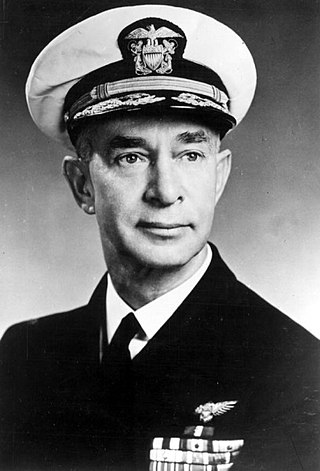
Frank Dechant Wagner was a highly decorated Naval aviator in the United States Navy with the rank of Vice Admiral. A Naval Academy graduate, Wagner distinguished himself as Commander of Patrol Wing Ten during operations against the enemy in the early weeks of the Japanese Invasion of the Philippines. He was then promoted to the general officer's rank and served as Commander, Aircraft, Seventh Fleet during liberation of the Philippines in 1944–1945.

















